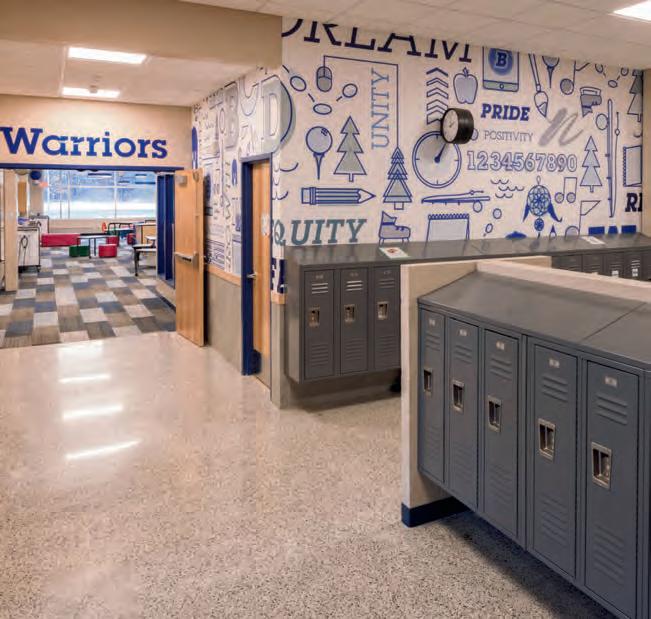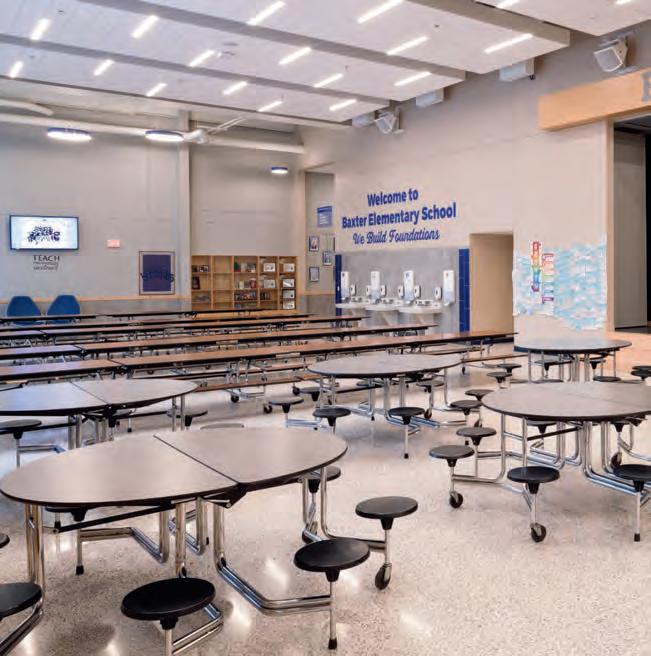A Place to Belong.
Reversal of Roles: When students become teachers

Unified Warriors: We see true friendships formed

Fall 2023
A Brainerd Dispatch Publication
Alumni Spotlight: Sarah and Tom Barrett


A Place to Belong.
Reversal of Roles: When students become teachers

Unified Warriors: We see true friendships formed

Fall 2023
A Brainerd Dispatch Publication
Alumni Spotlight: Sarah and Tom Barrett


 BY DR. HEIDI HAHN, SUPERINTENDENT OF SCHOOLS
BY DR. HEIDI HAHN, SUPERINTENDENT OF SCHOOLS

It was a summer packed with activities and celebrations, and we are beyond excited to have the entire Warrior community back together again!
This year holds special significance as we celebrate a remarkable milestone — our 150th year of providing public education to the community. It has been a journey filled with accomplishments and progress, and we are grateful for the integral role public education has played in shaping our community. Looking ahead, we await the discoveries and achievements that will shape our collective future for years to come.
I’m pleased to report the district is making great strides toward launching an updated Strategic Plan that will serve as a roadmap for our future. Thanks to valuable input and feedback received from the community during various input sessions, we’re confident that together, we can build a brighter and more prosperous future for our district and the communities we serve.
As the saying goes, “It takes a village to raise a child,” and I couldn’t agree more! Our students have boundless potential, and we owe a great deal of our accomplishments to our strong partnerships within the community. Whether
through donations to our food and supply pantries, volunteering in our classrooms, or simply providing encouragement to our students and staff daily — without it, we wouldn’t be able to achieve all we do!
With that thought in mind, this school year, we will focus as a district on “An Attitude of Gratitude.”
John F. Kennedy once said, “As we express our gratitude, we must never forget that the highest appreciation is not to utter words, but to live by them.” This is a valuable reminder for us to show our appreciation through our actions and how we treat others.
As I look back on all the things I am thankful for, one of the first that comes to mind is the many Brainerd High School alumni who returned to the district to build their careers here. Our fall magazine showcases these stories in addition to our Alumni Spotlight.
I encourage you to visit our schools to witness the remarkable community that draws our graduates back. There are numerous ways to get involved and appreciate all the amazing things happening in the district!
A Place to Belong—Brainerd Public Schools.
PUBLICATION STAFF
PUBLISHER
Pete Mohs
SPECIAL PUBLICATIONS COORDINATOR/ COPY EDITOR
DeLynn Howard DESIGN LAYOUT
Christopher Johnson
PHOTOGRAPHER
Joey Halvorson
Brainerd Public Schools magazine is produced by the Brainerd Dispatch in cooperation with the Brainerd Public Schools. Comments and story ideas: Annmarie.Lacher@isd181.org | 218-454-6904
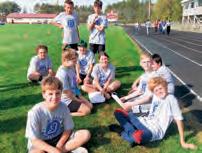
Advertising Support Opportunities 218-855-5895 | advertising@brainerddispatch.com
Copyright 2010 | Volume 13, Edition 2 | FALL 2023
506 James Street, Brainerd, MN 56401 (218) 829-4705 | www.brainerddispatch.com
ON THE COVER:
BPS Unified Warrior participants enjoy each other’s company at a flag football Unified event in Pillager.
Welcome Fall 2023
Superintendent’s Letter


 By Heidi Hahn
By Heidi Hahn
Brainerd Online
School is the BOS
By Sue SterlingA reversal of roles
By Sheila HelmbergerAlumni Spotlight: Sarah and Tom Barrett


150 years of Brainerd Public Schools
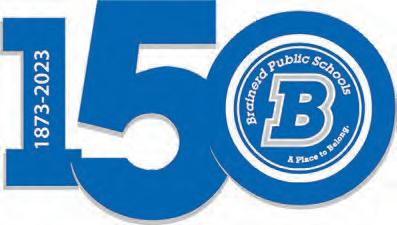
For the love of the game
By Sue Smith-GrierUnified Warriors: We see true friendships formed
By Sheila HelmbergerBrainerd Public Schools Foundation
By Sue ReadyDistinguished Hall of Fame
Adventures at a Glance




 BY SUE STERLING
BY SUE STERLING
Brandy Haglin is a local gal. As early as age 12, she realized she wanted to teach. Brainerd School District can take some credit for that. Her school days started in Brainerd at Lowell Elementary. Washington High and Franklin High rounded out her junior high days, and she graduated from Brainerd High School in 1999. She married her high school sweetheart, Morgan Haglin, in 2002, and they have two children, ages 16 and 17, who are now attending BHS as well.




You might recognize her last name. Her father-in-law is Mark Haglin, who started the farm program at BHS and taught everything from forestry to animal science. His father, Clayton Haglin, was also a teacher at BHS and retired in the early 90s. Grant Haglin, her brother-in-law, teaches Computer Science at Forestview. Her husband’s aunt taught FACS (Family And Consumer Science) otherwise known as HomeEc to a different generation of students.
What does she teach, you ask?
Brandy is the Brainerd Online School Coordinator. As a second grader, she remembers seeing an article in a Scholastic Magazine that said someday people could go to school in their pajamas, and that you would do it from home. Her mind latched onto that, and it stayed with her throughout her college and working career.
After completing her teaching license, she began as a social studies teacher, subbed for a while, and then motherhood intervened. She chose to stay home to raise her kids. As a mother of young children who wanted to continue her education, online classes were very valuable to her. She took online courses through the U of
M and through St. Cloud State University because traveling to those institutions was not possible. In 2012 she started working as an online high school teacher at the Minnesota Virtual Academy (MNVA), a fully online public school.
BOS — Brainerd Online School — is under the administration of Andrea Rusk, the school principal. Brandy Haglin is the coordinator of this supplemental program, which allows students to take up to half of their classes online. That usually means three classes per semester. Quite a few students take one online class, some take two, and fewer take three online classes, but that number is growing.
All the online classes are taught by qualified teachers, with a curriculum that is thought out, planned and deliberate. Not every teacher chooses to have online classes. They are given the
Online learning opens up access to learning from almost anywhere in the world for anything you want to learn. You’re not limited by distance, or by the availability of what’s being offered in your area. That is a major advantage of online learning.





Let’s start with the social life of students. A lot of students take online classes because they participate in other things, like sports, where competition requires them to travel to other schools. Or perhaps a student is going to be in the spring play and knows that rehearsals will require hours not conducive to attending class. Online classes make it more flexible to get work done in the hours that fit their schedule.
Now, let’s consider the introvert or the student(s) with social anxiety. They often shut down in a classroom environment, and won’t do anything to bring attention to themselves because they are worried about how it will look to their classmates if they ask a question. When you have students who are more introverted, who just find comfort in not being physically present, they are more likely to reach out to the teacher with questions because it’s in an online one-on-one setting. Or if a student takes longer to grasp the concepts presented in a classroom, with online classes they can go back and review the class as many times as needed. When they have questions, they can email the instructor or reach out to other students in the Discussion Board for that class.

Discussion Boards are online portals where the students can communicate with each other for help, feedback or inspiration from others who take the same class. Many friendships have developed between these students, as the discussion board connects them with others who share the same interests.



Asynchronous learning allows students to learn on their own schedule, within a certain timeframe. They can access and watch lectures, readings, homework and other learning materials at any time. Asynchronous online learning allows students to view instructional materials each week at any time they choose, making it more realistic for them to complete work each week at times that suit their schedule — no matter if it’s 3 p.m. or 3 a.m. BOS classes are asynchronous, meaning they are not live classes. Students can access the class any time of day. There are many students who thrive in an online atmosphere.


One of the things we see through online learning is self-advocacy and learning time management. Self-discipline and time management are important in completing online classes. To help parents keep up with what their student is doing, there is an online Parental Portal where parents can log in to see how much time their student has spent on their homework. Each student is required to engage in course work at least three times per week, and are expected to turn in the homework in the timeline assigned. Built-in algorithms alert parents and teachers to non-attendance.
BOS is a supplemental program for students in grades 9 through 12 only. They cannot accept homeschooled students. However, if the student is fully registered in another school district, they could take classes through Brainerd Online. If you’re a student living in Little Falls, you can go online and research what Brainerd Online School has to offer. You can even talk to the teacher or to Brandy, then decide if that is the right class for you. You can do that with other districts who offer online classes. It’s a matter of finding the district that fits your needs.
Finding the right class is where the work is. An individual student or family has to do their homework to find the course that is right for them. It’s kind of like finding the right doctor, but doctors don’t make house calls anymore. Online classes do.

Shannon Finnegan, Agent Finnegan & Associates, Inc
406W Washington StSte4 Brainerd, MN 56401
(218) 829-3040

sfinneg1@amfam.com


 BY SHEILA HELMBERGER
BY SHEILA HELMBERGER
Lots of people find themselves returning to their hometown when it’s time to start their careers. In ISD 181 it is especially sweet for those who grew up walking the halls of the district schools as students to return as teachers.

Anne Campion is starting her second year as an elementary teacher and Tom Andresen kicks off his 32nd year with Brainerd Public Schools.
“I’m excited,” said Campion of teaching kindergarten at Lowell. Last year she taught first grade in the school.
Growing up in Baxter, Campion was an elementary student at Lowell herself, then went to Forestview Middle School and finally Brainerd High School. Graduating from Concordia College in Moorhead, she completed her degrees in elementary education and Spanish.




Anne’s mom, Kari, has been a teacher for 34 years and currently teaches third grade at Baxter Elementary School. Campion says when she was growing up, she visited her mother’s classroom sometimes but never felt any pressure to go into the same field.

“Of course, I considered other things,” she says of her career. “But in the end teaching was a natural decision for me. I did not really plan to come back to Brainerd. I thought I would end up somewhere else.”
After job hunting a little in the Fargo-Moorhead area, she saw an opening at Lowell.

“It felt right,” she says. “So far, I have loved it. It is nice to see familiar faces. There are a lot of great teachers here and people that I had as my own teachers are now my colleagues, which is fun. I’m excited for year two.”

A lot has changed in the district since Tom Andresen attended as a student. He went to Nisswa Elementary School through the sixth grade and then onto Franklin Middle School for seventh and eighth grade and Washington for ninth.



“I was a Warrior football player and a Warrior wrestler and a weight room kid,” he says of his years at Brainerd High School. After graduation he played a little football at Brainerd Community College and Bemidji State University.
“I went to BSU in hope of landing a teaching job in a small northern Minnesota community,” he says. “The opportunity arose to come back to the Brainerd lakes area, and I was OK with that. A lot of kids wanted to leave Brainerd and the small town. Not me. I liked Brainerd.”
Andresen has worked in a variety of positions during his years in the district. He spent his early years teaching in special education and started the MN Learning Center under psychologist George Tetreault. He worked for seven years at Franklin as part of the MLC program.
These days you can find Andresen teaching fifth grade science and health at Forestview Middle School. He has continued his passion for athletics by coaching eighth grade
There are a lot of great teachers here and people that I had as my own teachers are now my colleagues, which is fun. I’m excited for year two.
- Anne Campion
football. Andresen says another one of the biggest highlights of his teaching career was introducing the kids to the great outdoors during an annual winter trip for two nights to Deep Portage when he taught at Garfield Elementary School. “It was great to see kids get out of the classroom and do things in nature. A cool part of that was seeing the results going back into the classroom, too.” Students write about the experience for their narratives and there is lots to talk about, he says, when you were climbing rock walls and snowshoeing, having campfires and new experiences. “People always wonder why we take that trip in the winter,” he says. “But the students are not ready in September, October or November. But by January, you’ve kind of built a team.” He has continued to teach students nature skills at FMS by using the school forest as a classroom.

Andresen has also enjoyed helping students with strength training throughout his years in the district, and training students to prepare for the annual Sertoma Liftathon. “It’s working with students all winter, male and female,” he says, “We get to see them become more confident and watch them make and meet their goals.”
He says he has seen many changes in both coaching and teaching over the years.
“I like working with kids,” he says. “It’s just fun. I like the engineering I am doing now. We are problem solving. We work with wind powered cars and parachute engineering. I tell these kids it is OK to fail. Then you must make a new plan.”
He acknowledges that a new challenge that teachers have is competing with screens for students’ attention. “We used to read cereal boxes and then do the mazes,” he says. “Times are changing though. Now, we even teach on screens.

Andresen said Brainerd schools are great. “I am a firm believer in what we do,” he said. “I work hard with the kids. It takes consistency and connection. Humor is good. If you ask kids, they will say my class is fun, but I also hold them accountable. I call it Grandma’s Rule. We must eat our vegetables before we get our dessert. We do our hard work and then we’ll play later.”
Andresen spends his summers on a houseboat “a little farther up north” but says teaching has been a rewarding career for him. “We put in a full day,” he says, “We keep a good pace. But I love it.”
I am a firm believer in what we do [...] If you ask kids, they will say my class is fun, but I also hold them accountable. I call it Grandma’s Rule. We must eat our vegetables before we get our dessert.
 BY SHEILA DECHANTAL
BY SHEILA DECHANTAL
Siblings Sarah and Tom Barrett graduated from Brainerd High School in 2004 and 2001, respectively.
The siblings grew up on a 2,000-acre farm and knew from a young age hard work pays off. Between helping at the farm, school, and after-school sports, their lives were full.
After graduation, Tom went to the University of North Dakota for aviation and Sarah chose a community college in Arizona.
Coming home on summer break in the early 2000s, Sarah found out her father purchased a used twin-screw extruder from Norway to produce organic fertilizer for golf courses. Sarah helped her father over the summer to do the paperwork and help in the office. As things were taking
off, Sarah made the decision not to return to school and stay and help her father.
In a short time, it was discovered the machinery their father purchased was actually meant for making premium pet food. This was the beginning of Barrett Petfood Innovations.


In 2008, Tom started to work remotely on the marketing side, eventually moving back to the area to become partners with his sister to grow the business.
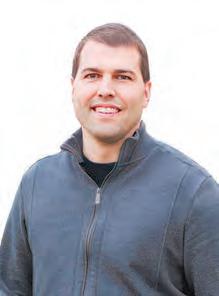



While not always easy in the early years, they put their all into making it work, eventually landing large contracts that gave the business the push it needed to continue to grow and expand. In 2011, they began to make profit and have continued to do so ever since.

























As of now, Barrett Pet Innovations not only exists in the original location in Brainerd, but in 2020, they opened a second location in Little Falls, employing more than 250 people overall and making 85% premium dog food for many well-known companies, 10% cat food and 5% bird food.









And that original used twin-screw extruder? It still works and is the only original piece in the Brainerd location — being one of two in the United States.

Sarah and Tom never dreamed they would ever work together, let alone run an established business together — yet here they are. They are excited to see what the next generation will contribute to the family business.

Holden Electr ic Co.,Inc. is a prou dsupporter of the BrainerdSchoo ls, and thankful for the opportunity to be working on the newBrainerdHighScho ol remodeland ad dition.
ScottMoser BHSClassof‘84 SeniorEstimator


In January 2023, Brainerd Public Schools began the celebration of its 150 years (1873-2023) of providing public education as a school district. Initially, education was only provided within the city limits of Brainerd. By order of the Minnesota legislature, country schools, and smaller school districts were consolidated into the Brainerd Public Schools. Today, Brainerd Public Schools is spread across 516 square miles, including Cass, Crow Wing, and Morrison Counties, and serves more than 6,700 students annually at six elementary schools, one middle school, one high school, and three alternative programming sites, as well as a new online learning option. 1872 1874 1885

The first school board meeting of ISD 181 was held on December 30, 1872, at the Brainerd Tribune office. Elected school board members included M.C. Russell, Chauncey B. Sleeper, E.B. Lynde, Lyman F. White, Leonard B. Perry, and Warren Leland. School board member Leonard Perry was elected superintendent of schools, with Nettie Ladd, and Julia Fitzgerald hired (for no more than $55 per month) as the first teachers to lead instruction from January 1 to April 1, 1974, at the Baptist Church.

In 1873, Brainerd’s first effort to build a public school failed when voters decided not to issue bonds for $3,500 for two school buildings. After the legislation was passed, a mass meeting was called to vote on a tax not exceeding eight mills on the dollar to acquire land and build schools at $2,500.


South Sixth Street School opened for instruction on January 6, 1874.

The South Sixth Street School was located on lots near the southeast corner of South Sixth Street between Oak and Norwood; the Lake Superior & Puget Sound Company, a subsidiary of the Northern Pacific Railroad, donated the lots.
WASHINGTON HIGH SCHOOL OPENS
On January 26, 1885, a parade of teachers and students, along with the city band and school board, marched from the Sixth Street School to the newly completed high school.
BOARD MEETING HELD From left: M.C. Russel and Chauncey B. Sleeper.In January 1887, Sue B. Mulrine became the first diplomaed graduate of Brainerd Public Schools. The ceremony was held at Sleeper’s Opera House.
In April 1893, A. Tollefson of Minneapolis was awarded $39,672 to build four new grade schools.
All four schools, Harrison, Lincoln, Lowell, and Whittier were identical, and it is said that they were built with Brainerd-made Schwartz brick.


Brainerd was growing and stretching out to the northeast and west.
Riverside was built in west Brainerd.

Brainerd was growing and stretching out to the northeast and west.
Garfield was built at the Corner of 9th Avenue NE and N Street.
FIRE DESTROYS

WASHINGTON HIGH SCHOOL
On March 31, 1928, Washington High School is destroyed by fire. The Brainerd Fire Department received a call at 12:46 a.m. The entire north section of the building was in flames upon their arrival. Thirty-eight firefighters fought for eight hours to contain the fire.
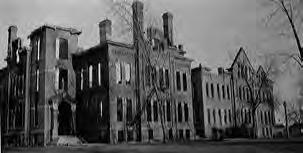

At 1:30 a.m., Superintendent Wilbur C. Cobb, Principal Mary Tornstrom, and firefighters risked their lives by entering the burning building to rescue student records, taking them out of the two office safes.
NEW WASHINGTON HIGH SCHOOL
On January 6, 1930, the new Washington High School, which cost nearly $600,000, was ready for occupancy, housing grades seventh through twelve.




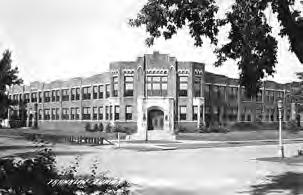
Construction began on the Franklin Junior High School building at a cost of $300,000, on the corner of North Tenth and Juniper Streets. The original schools built in 1894 were deemed inadequate and torn down. The investment to build all four new schools was nearly $900,000.



The south side of Brainerd was showing tremendous growth, while the original Garfield and Riverside frame structures were becoming too small to accommodate the growing number of students within their boundaries. Edison, the new Garfield, and the new Riverside (all one-story buildings) opened in 1955.

On March 1. 1966, the Brainerd Public School District voters voted in favor of a bond issue of $3.5 million to build a new high school located on South Fifth Street between Oak Street and Quince Street. Construction began in 1967.
Classes began at the new Brainerd High School in September 1968.
In April 2002, Brainerd School District voters approved a $59.9 building bond referendum to build Forestview Middle School and remodel Brainerd High School and the former Mississippi Horizons building.


In January 2005, about 1,400 students at Washington Middle School and Mississippi Horizons moved into Forestview Middle School while Franklin students finished the school year at the 73-year-old school.

On September 6, all district 5th-8th grade students began the new school year at Forestview.
Due to a failed funding referendum, the district needed to cut $5.5 million to cover its budget gap. Whittier Elementary and Lincoln Elementary were closed. The last day of classes was Friday, May 30, 2008.



On April 10, 2018, voters approved the $205 million bond referendum, giving the district the go-ahead to begin the construction of its final comprehensive facilities plan, which included building a new Baxter Elementary School, repurposing all six elementary schools, and remodeling the Brainerd High School north and south campuses, as well as the Brainerd Learning Center.


CONSTRUCTION COMPLETE ON NEW BAXTER AND RENOVATED HARRISON AND NISSWA ELEMENTARY

The new Baxter Elementary and renovated Harrison Elementary and Nisswa Elementary were completed before the first day of school, September 8, 2020.
On January 31, 2022, an open house was held in the new career and technical education wing of Brainerd High School.


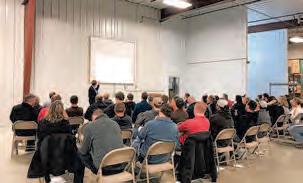
Student tour guides led groups through the high school’s new spaces, which included rooms for agriculture, welding, mechanics, robotics, woodworking, engineering, computeraided design, and family and consumer sciences. Teachers and students showcased recent work and projects.
Renovations and additions were completed on Garfield, Lowell, and Riverside Elementary before the first day of school, September 7, 2021.
A dedication ceremony was held on November 22, 2022, for the new Lincoln Education Center, now housed at the previous south campus of Brainerd High School, which serves special education students and hosts transitional programming.
After serving over 20 years as the coordinator of Parks and Recreation for the Brainerd/Baxter area, Joe Pohlkamp has retired and is looking forward to enjoying the fruits of his labor. Spending a few minutes with him reveals where his heart is and what motivates him.
 FALL ‘23
FALL ‘23

“When I started with the program,” he began, “and trust me when I say this, yes, I was in charge, but I had a lot of great people helping us build the program. One of my goals when I started this was, I really had a vision of Brainerd and Baxter coming together as one community. There’s a lot of pride about the athletes we have and the kids we have, and the community we have to make this a better place.”

When the Brainerd School District took over the Parks and Recreation for the two cities, Pohlkamp envisioned a united community that could do so much for the kids by offering fun, yet competitive baseball and softball teams. Working with others, he was able to establish a traveling team so the young players in the league would have the choice to travel and compete with other teams.

“For 20 odd years we built the program up. We sent three teams from Baxter to the World Series.” One year the team went to Maryland where they met Cal Ripken and his brother Billy. Among Pohlkamp’s fondest memories are when he got to coach his son’s team and they played in the World Series. Twice, he was able to go to the World Series with them.
“One of the things I learned was that when kids come up to the baseball park, that’s their major league baseball game. They may not make it to the major leagues, but to see the grass mowed and the field dragged, the chalked lined field . . . it’s such a good feeling, such a good atmosphere. This is their major league game. And to give them that feeling it takes great coaches and we’ve had great coaches and made these kids feel good.”
His diligence and that of the other adults working with the program cultivated and nurtured in the youths a love for the game. Good sportsmanship and teamwork are by-products of a successful athletic endeavor and Pohlkamp worked to ensure these were not left by the wayside. “It’s not about the wins and losses. It’s about the kids and the different things they’ve done or said.” He reminisces about some of the kids and chuckles.
The program also serves as a social outlet. “With school not in session, this is when they can get together with their classmates and friends twice a week and play baseball and softball. I was director over both baseball and softball, but I always had another person directing the softball. To be honest with you, it was about the kids and how much fun they had. And to this day, I still love it — to go to a game and hear the kids cheering, having fun and trying their hardest to do everything they can to accomplish the game and have fun.”
Pohlkamp always coached the minor leagues which was a pitching machine league with 6 year olds. Even now that remains his favorite age to coach. The kids would dress in full uniforms. He always made sure their shirts were tucked in and he instilled in them the pride of looking like
I really had a vision of Brainerd and Baxter coming together as one community. There’s a lot of pride about the athletes we have and the kids we have, and the community we have to make this a better place.
- Joe Pohlkamp
their major league counterparts. In this way, he set standards for the leagues so the kids would take pride in the game and themselves. “We look good, we play good.”
“It was very rewarding, and I had great people to work with. I worked with the City of Baxter for how many years, and they were great people to work with.” Certainly, there were challenges, but for him, it has always been for and about the kids and providing a safe and fun experience for them. Pohlkamp also credits Roy Rauen for his part in making the program a success. “He designed these fields and they’re beautiful out there. He’s a great guy.”
“So, I walk away from it feeling Brainerd and Baxter, this community is in really good hands.” For the past two years, his vision of Brainerd and Baxter coming together as one community over the program has become a reality. “The cities really care. They want to have the best program possible.”
Pohlkamp did express hope that the traveling team, which had pulled out from the league to exclusively play travel ball, will eventually join back again. He would like to see all the teams united again to reflect the oneness of the community.


“I’ve been doing it for 20 years now and I feel it’s time for someone else to take over. I feel it’s time for new blood in there.” Needless to say, he is looking forward to the joys of retirement, but is also enjoying the prospect of going to games to watch and cheer the kids on without being directly involved.



To honor the work he has done with the Brainerd/Baxter program, Pohlkamp was inducted into the Minnesota Baseball Hall of Fame. “That was pretty special,” he said. “I was still coaching so now when I look back at things, to have the State of Minnesota and some people recognize you for the things you’ve done, it feels pretty good.”
He is grateful to all the coaches, parents and people who have helped make it so special over the years but most importantly he thanks all the kids who have played. Pohlkamp’s biggest acknowledgment goes to his wife Mary. “I have to say I give credit to my wife. She’d come home from work and I’m walking out the door. For all these years she’s let me do this. This wouldn’t have happened without her.”
“The goal is to enjoy the game of baseball. The goal is to have fun.”






There’s always an excited buzz in the halls at Brainerd High School at the beginning of a new school year. But there’s probably one group of students that are especially happy to see one another.
The Unified Warriors program partners general education students with students in the special education program and creates rewarding relationships for both.

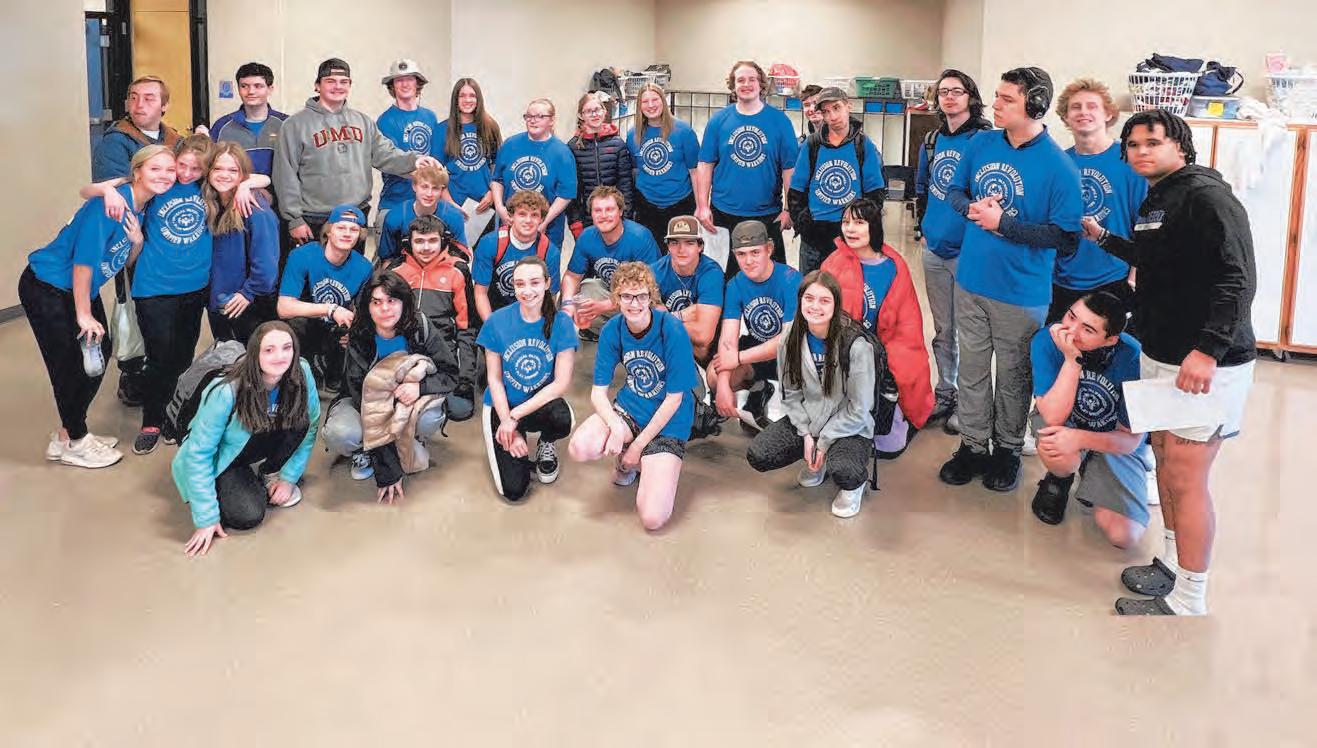

Emilee Freed is a special education teacher at Brainerd High School. She fills the role of adviser for the Unified Warriors program. “We’ve been around for about six years,” she says. The program operates under the Special Olympics of Minnesota. While members of the Unified Warriors are all students at Brainerd High School, they do not have to be in the same grade to be paired up. They find one another by participating in small groups or getting matched up by staff. Initially, general education students became involved in the program after learning about it by word-of-mouth from friends and other students.
Special education students become involved with Unified Warriors by participation in the DAPE (Developmental Adapted Physical Education) class, attending the twice weekly WIN (What I Need) class, or by taking part in a Special Olympic event. Freed says sometimes two students are such a good match with one another that they will remain partners for years.“It is so fun to watch them connect and get to know one another,” she says. “Sometimes they’ll see each other in the hallways, socialize at lunchtime or before and after school. It is a pretty cool thing to see.”
Students travel by bus when they go to other schools where they join similar groups for various athletic events. All are held during the school day with about 50 kids participating from Brainerd. The Unified Warriors travel to Pillager for flag football and track and field, and to Staples for basketball. The Brainerd group hosts bowling at Jack’s House and new this year, swimming will be added to the schedule with Brainerd hosting in the completed state-ofthe-art pool at the high school.
The annual Camp Confidence Winter Carnival event is a popular highlight for Freed and the Unified Warrior students. “Even if it’s cold that day, she says, “it’s my favorite day of the year. Students get a chance to experience winter activities including ice fishing, dog sledding, snow tubing and snowshoeing. “It really is just so, so fun for everyone.”
The longer the program goes on, how rewarding it is for students on a larger scale comes to light as well. “We have a few students who have gone through the four years with us and are in college now studying special education. A couple of former students want to be special education physical education teachers and teach DAPE, and there are students who want to go into the medical field and have a high interest of working with people with disabilities.”
The interaction of the Unified Warrior students is rewarding for Freed, too. She says she has always had a passion for inclusion with students of all abilities interacting and spending time together.




When the students see their friends from the program out in the halls or run into one another outside of school, it is fun for both students, says Freed. “We see true friendships formed.”

 BY SUE READY
BY SUE READY
The mission of the Brainerd Public Schools Foundation (BPSF) is to enhance opportunities for the students of the Brainerd Public Schools through the 4As, Academics, Arts, Activities and Athletics. Their vision is to enable all individuals to reach their full potential as learners, participants, citizens, artists, athletes and contributors to our community.


BPSF is a nonprofit 501(c) 3 that serves more than 6,700 students per year from the Crow Wing, Cass and Morrison counties. Student attendance is spread out over six elementary schools, one middle school, one high school, three alternative programs and a new online learning option. The dedicated board of directors guides and facilitates its mission of service and growth. The board consists of community members, along with representatives of the
School Board and Administration. The executive director is Jessica Gangl and marketing and administrator coordinator is Stefanie DeVries, who are both Brainerd High School alumni. BPSF exists to support the Brainerd Public Schools, including offering scholarships and providing 4A Grants to students, staff and coaches. The Foundation was created in 1987 to simply facilitate and encourage scholarships. Over the years, the Foundation has grown from three initial donations
to more than 90 dedicated scholarship funds, issuing over $180,000 in scholarships in 2023. These funds have been created by businesses, high school classes, memorials to teachers, students and citizens, and by community members who care deeply about students continuing their education beyond high school. The Scholarship Recognition Night is an annual event in May.





In addition to scholarships, BPSF has made over $500,000 in grant monies available since 1996. The 4A grants are designed to support the arts, academics, athletics and activities. School staff are encouraged to apply for funds that help carry out unique innovative programs for projects they want to implement that limited general operating dollars can’t support. The 4A grant cycles are open to all schools and school sponsored sports to request funding. Last year, BPSF had two grant cycles within the school year awarding nearly $50,000. This year the grant deadlines are Oct. 24 and Feb. 20. Grants are not for buying curriculum but for enhancing
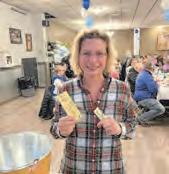


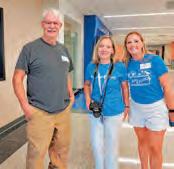

opportunities within the schools. When 4A grants are requested, consideration is given to the scope of instructional impact. Does it align with District goals and best practices? Is it in compliance with safety standards? The average grant size is typically $1,000. If the projected project exceeds this amount there is a need to show how partial funding would be possible to support grant monies. Specific criteria for applications can be found online at the BPSF website.



Videos of some of the innovative 4A grants in action are on the BPSF website at bpsf.org. They include physics class materials to demonstrate Waves and Particles concepts, a bridge building contest that encourages collaboration and team building skills, iPads to support an orchestra teacher’s assessment of individual pupils, and Little Bits, problem solving skills through machinery construction. Other grant classroom enhancements include classroom birdhouse building, author visits and books for classroom libraries. Check out BPSF’s Instagram and Facebook postings for

updated photos.
Last year’s 2023 Big Event, a dinner and auction, raised $75,000. The 2024 Big Event is scheduled for Feb. 3, 2024, and a smaller fundraiser, Bingo at the Brainerd American Legion, will be on Dec. 4. Each of these fundraisers support BPSF’s mission and operations. Donations are tax deductible.

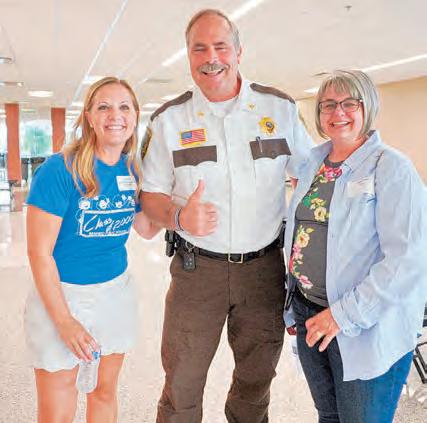





Donors have been generous in their spirit of giving to support the school district. These patrons run a wide range, including past educators, alumni, new people to the community, those passionate about education, specific donations to a particular graduating class, legacies left by teachers who have passed away, and donations earmarked for a particular graduating class or athletic programs. Families or groups can create a specific scholarship, and a donor can be connected to individuals who share similar goals. Donations can easily be made online through the BPSF as well as to the GIVE to the Max Day in November, an opportunity to help the BPSF sustain their mission and programs.
The Warrior Club is a newly created opportunity for donors to support the Brainerd Public Schools Foundation through an annual commitment. Businesses will receive recognition in a variety of ways throughout the year including event recognition, social media, and print. Individual donors can easily make a one time annual gift or choose a monthly contribution to continue to support BPSF
throughout the year. This is a great way for alumni to get involved in supporting their alma mater!
BPSF hosts an in-store and online Warrior Store, selling spirit wear throughout the year located at 214 S. Seventh Street in downtown Brainerd. The online store is typically open August to December. A link to the store can be found at bpsf.org. Proceeds from sales benefit BPSF helping further their mission. Currently the Foundation is hosting “Warrior Worn” initiative. Gently used Warrior gear was collected in the spring and is being sold at the Brainerd Warrior Store. One hundred percent of proceeds from this initiative will benefit the school district food and essential pantries. School pantries are accessible to students who have needs for food, hygiene items, school supplies, clothing and shoes.
Gangl notes, “I couldn’t be more proud to be part of the good work the Brainerd Public Schools Foundation does in our schools and for our students. We have a dedicated crew working hard to raise precious funds to enhance opportunities for the students of the Brainerd Public Schools. We know the return on this investment will be great.”
It is evident opportunities abound to support the Brainerd Public School District which will further their programs offering innovative quality education and build upon that success for future growth.
This year marks 150 years of Brainerd Public Schools and will see three more graduates enter into the Distinguished Achievement Hall of Fame. Craig Arnold, Ruth Gmeinder and Amy Sands join 79 other Brainerd graduates, honored for their accomplishments and contributions to their communities.
The induction ceremony is set for Sept. 29 at the Gichi-ziibi Center for the Arts as a part of this year’s homecoming celebration.
interests, keen instincts, unique insightfulness, abilities to engage others in causes, extraordinary “natural” skills, adaptability to circumstances, calmness under pressure, elevated learning abilities, creative responses to life’s offerings.
Craig Arnold (BHS, 1972) describes himself as a “conductor, educator and entrepreneur.”
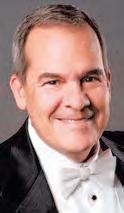
Craig now joins his late father, John (Class of 1937), a Minnesota resorter, prominently decorated, entrepreneurial hospitality industry giant, in the Distinguished Achievement Hall of Fame — the only such parent-child coincidence in DAHoF history. But “titles” alone, including “Distinguished Achievement Hall of Fame,” are nothing.

High school “achievement” can be indicative of future life: Kindness toward others, willingness to work hard toward academic, athletic and community goals, broad ranges of
Craig Arnold was student council and student union president his senior year. Little known is that he also was state president of the Minnesota Association of Student Councils, believed to be the only BHS student to have organized and persuaded his statewide peers, from hundreds of student councils around Minnesota, to elect him to “the top of the top” of high school student government.
Craig “multi-tasked” in high school, singing in BHS choirs, backstroking on the swim team, co-chairing the Foreign Student Committee and as co-editor of photography in the yearbook, learning endurance, teamwork, visualizing and related editorial decision making skills. As an academic, he was admitted to the
30,000 sq ft indoor waterpark includes:



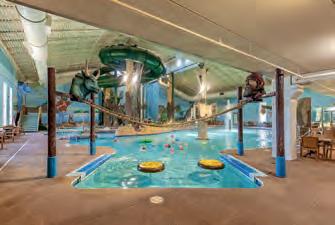
• Four-story body slide & Tube slide
• Zero-depth entry pool


• Lazy River
• 2,400-square-foot Gold Mine Arcade
• Paul’s Place & Babe’s Barn Private Party Rooms
• and much more!
National Honor Society and graduated with honors.
Realizing that diversity, and learning about life in cultures other than the dominant culture of 1970s central Minnesota, yet today integral in Craig’s business life, Craig became an American Field Service foreign student in the Philippines.


“Music” did not run in the Arnold family, although his parents sang in the church choir. Perhaps through his first BHS choir director, Michael Smith, performance level music and the teaching and learning of it, became his passion. As Dr. Arnold, he has raised music performance and education to extraordinary levels.
Dr. Arnold’s post high school education began at St. Olaf (BA, Music), then the University of Illinois (MA, Music Education) and finally the famous Eastman School of Music at the University of Rochester (DMA [Doctor of Music Arts] Choral and Orchestral Conducting. Along the way, Dr. Arnold conducted choirs and orchestras of all ages and served as an educator of graduate, undergraduate, high school and middle school students in Minnesota and Iowa, in addition to music ministry experiences serving on church staffs in Minnesota, Iowa, Ohio and Michigan.
Dr. Arnold’s academic music performance and educator skills continued to be both learned and applied at Capital University, Columbus, Ohio, as Director of Choral Activities at Western Michigan University, Kalamazoo, Michigan, and at Luther College, where he was professor, Director of Choral Activities and conductor of the Nordic Choir, a recognized and awarded internationally renowned choir. At Luther, his predecessor had served for 57 years and, in the early 1970s, had guest conducted the BHS a cappella choir in which then BHS student Craig Arnold sang.
Years later, Dr. Arnold returned the favor, bringing his Nordic Choir to BHS to sing, and Dr. Arnold to conduct, in concert with the BHS choirs of Dr. Arnold’s BHS sophomore year BHS choir director, Michael Smith, who was retiring that year. While in Brainerd for his DAHoF induction, Dr. Arnold will conduct with Mr. Smith again, on September 30 at the free Curt Hansen Memorial Homecoming Concert, “Coming Home,” directing a pick-up choir of community members who just want to sing, doing so along with other former BHS choir directors.
Dr. Arnold has conducted in most of the United States, frequently at Carnegie Hall, Lincoln Center, Orchestra Hall in Chicago, and other major venues throughout the world. He often is a guest lecturer for teacher and conductor training and a guest conductor at workshops, festivals and state choirs across the country.



Soon to be his 25th year beyond academia, Dr. Arnold founded the MCP Performance Group in 1999, Dr. Arnold’s entrepreneurial side, breaking into full stride in MCP, at the same time maintaining his conductor persona and his always present educator self, in what is now an esteemed production company in New York City. MCP exists to provide participants in its programming with “exceptional musical and cultural performance opportunities,” with production and performance activities being guided by “principles of musicianship, unparalleled hospitality and intrinsic value.”
MCP consists of Manhattan Concert Productions, concert performances, an online learning center, Fine Arts Funding and the professional Manhattan Chorale and Chamber Orchestra. MCP has provided performance, travel and educational opportunities to thousands of musicians in choirs, including BHS choirs under BHS director Brian Stubbs, bands and orchestras at famous venues throughout the United States and abroad.
Choirs under Dr. Arnold’s direction have performed at state, regional and national conventions, toured throughout the United States and abroad, and have produced numerous CD recordings. The national broadcast of Christmas at Luther 2008, with Dr. Arnold as Artistic Director, received a regional Emmy award. The University Chorale, Western Michigan University, under Dr. Arnold’s direction, won first prize at the prestigious international choral competition in Wales.
Craig Arnold has served as a frequent guest lecturer and conductor throughout the United States and abroad, having appeared in Japan, England, Scotland, Germany, France, Italy, Wales, Hong Kong, China, Russia, the Czech Republic, Spain, Austria and most of the United States, including Alaska. On Sept. 30, he will do so again at the Gichi-ziibi Center for the Arts on the campus of his alma mater, Brainerd High School, in the inaugural homecoming pick up choir, free choir concert, the Curt Hansen Memorial Coming Home Homecoming Concert.
Dr. Arnold is passionate about choral and educational opportunities for excellence. Several of his students, graduate and undergraduate, have been finalists in the student conducting competition of the American Choral Directors Association. Curt Hansen, for whom the BHS Coming Home Homecoming Concert is in part named, was a founder of the ACDA and is a member of its hall of fame. In 1972, Curt Hansen guest conducted Craig Arnold and BHS choirs in concert in Brainerd.
Fifty-one years after Craig Arnold’s BHS graduation, the cycle appears to be complete, but history tells us that it is not. Yet.

Ruth Henderson Gmeinder (BHS 1971), a longtime resident of the Brainerd lakes area and an integral, hands on part of the Brainerd lakes resorter community, was a Brainerd Public Schools Board of Education member for almost 20 years, an extraordinarily long period of public service, from 1992 through 2011. As a board member, “Ruthie,” as she is commonly known, was selected as the 2004 Minnesota Outstanding School Board Member and keynoted a national conference on school districts, public health and medical collaboration.
Her school board service was not her only contact with Brainerd Public Schools, however. Ruthie was president of the Latin Club at BHS, downhill skied competitively and was an officer of the Student Council in her senior year (serving with her fellow Hall of Fame inductee, Dr. Craig Arnold, a class behind her. She graduated from BHS with honors, at 17.
In addition to being a BPS parent after returning to Brainerd, Ruthie also served as a member of the Community Education Advisory Board, a key connective link between the Brainerd Public Schools community and adult education on a broad array of subjects, always at little or no cost to those who sign up.
A mom herself, Ruthie’s post-secondary education aligned with the interests and needs of young children and families. She was a member of the Early Childhood and Family Education (ECFE) Advisory Board, concerned with implementation and performance of a key Minnesota public education program which even decades ago recognized the critical importance of early learning for children and their families. And Ruthie was there.
Whatever she does, most of which is not generally known to the public, Ruthie is a “presence.” She has made intricate costumes for charitable causes for years, perhaps her “public signature” of today, and many of those costumes have been seen in opera productions of the Lakes Area Music Festival, in fundraising efforts of area charitable organizations, and in support of local theater productions, but also in less obvious places, such as at “destination locations” for field trips taken by school students. Possibly, say some who have known her from her leadership days as a student at BHS, Ruthie’s creative flair dates back at least as far as BHS Homecoming parade floats she designed which won awards for her eyecatching use of colors and materials.
After graduating with BHS honors, Ruthie repeated that academic feat by graduating with honors from the University of Minnesota, again a year early, in three — not four — years, with a degree in dietetics. After dietician work at the U of M Masonic Cancer Center and in the St. Paul School District, the latter being her first public service undertaking, she became a Crow Wing County Women, Infants and Children (WIC) leader
and public health administrator, a WIC grant writer and then co-owner of the Gull Lake Resort.
Over the years since returning to the Brainerd lakes area, Ruthie also served on the Crow Wing County Child Protection Team, the Community Action Board, the St. Joseph’s Home Care Board, the Family Services Collaborative Board, the National Joint Powers Board, the Happy Dancing Turtle Board, the Brainerd Lakes Area Community Foundation Board, and the Women’s Fund Board, never “in name only.” Each of these boards were and are deeply concerned with “others,” not self, and each were and are missionary in their respective focuses on literally caring for those most in need.
It is hard not to notice the engaged presence of Ruthie Henderson Gmeinder in a room, literally and figuratively. Her personality lights up the darkest of spaces; her character, intelligence and drive immediately leads others to action. Deservedly, she has been publicly noted for her contributions:

Locally, she has been identified as Outstanding WIC Director, and has been the recipient of the Sertoma Service to Mankind award, the Athena award for a woman leader in her community, the prestigious Citizen of the Year award, Rotarian of the Year and Women Making WavesWomen’s Fund – award.

On a broader scale, Ruthie was recognized by the Minnesota Jaycees as an Outstanding Young Minnesota. She would be among the many volunteers throughout history who have found that the more one gives to others, the more one receives in return, true across the board of her life of giving here, but because of the foundational and broad impacts on life of her volunteer work in initiating a Minnesota School Board Association award winning literacy promotion program for Brainerd school children implemented through Rotary, incidentally resulting in a Rotary Regional Award for that program, it is this contribution she has made which she is most proud of.
Ruthie’s costuming work continues for local nonprofit fundraising purposes, and given the brilliance of her work in costuming others for all manner of “do good” events, it is little known that she also has gifted many of her freely made costumes for charitable fundraising. Those sales have raised some $300,000 for the good of nonprofits in the Brainerd lakes area.
In another place and time, Ruth Henderson Gmeinder might have taken her considerable professional skills in caring for people and her very unique professional costuming skills to Hollywood, or to Broadway, or to any number of points in between, for personal profit and possibly national acclaim in an industry known to publicly award the talented.
Ruth Henderson Gmeinder returned home, instead, and like so many talented and caring others in Brainerd’s lake country, has improved the lives of all of us here, in some way, sometimes known by us, and often not. Of all the things she knows of so well, Ruthie still says this:
“Education is the greatest gift we can give our children, and education is a lifelong learning process.”
Ruth Henderson Gmeinder BHS, 1971Education is the greatest gift we can give our children, and education is a lifelong learning process.
- Ruth Henderson Gmeinder
Amy Sands (BHS 1989) was selected as Fine Arts Student of the Year in her senior high school year. Today, she is a tenured professor of art at Metropolitan State University, St. Paul, galleried artist in New York City and Tokyo, sought-after participant in international exhibitions, noted winner of major Minnesota and international art fellowships and awards, and dedicated professional in both the teaching and thoughtful making of art of the highest order, belying the wrongheaded “saw” that those who can’t, teach.

The dedication necessary to get there from here, the creative intelligence behind Amy’s conceptualization, then realization of artistic expression in the several media she is expert with, and the steely physical and mental discipline required not only to perform, but to perform both practically and spectacularly in her media and her arena of choice — the international community — were foreshadowed at Brainerd High School. Shakespeare told us, the future, 400 years ago in The Tempest, that “What’s past is prologue.” “History” — the past — sets the context for the present of Amy Sands, today.
At BHS, Amy was an honor graduate who learned more than “book knowledge,” an unstated aim of a well-rounded education. She learned movement, precision, commitment and creative passion with her state championship BHS danceline teammates. In Symphonic Band, she learned the same, symphonies in music rather than the symphonies in the visual arts. As editor-in-chief of the Brainonian, she learned
all of that and the art of driving of self and others to and through deadline after deadline to produce the timeless art of a “print,” a quality yearbook.







Amy double-majored in Art and Communication, graduating with great honors from Concordia (Moorhead), then went to the esteemed Pratt Institute, Brooklyn, New York, where for her Master of Fine Arts in Printmaking, with minors in Drawing and Painting. She has taught in various faculty roles at the University of Nebraska, Minneapolis College of Art and Design, Central Lakes College, Macalester College and Metropolitan State University where she now is chair of the Fine Arts Department. Her tenured professorship is in Studio Arts, the doing of art.
Much of Amy’s artistic expression is, in her words, “centered around the artistry of historical textiles,” what she calls “beautiful handiwork treasures that are often forgotten and buried in the basements of museums.” They are “artistic works,” “cultural artifacts” and “treasures of history.” Amy’s mission is to “bring these works,” from what she describes as “the domestic space that women were often creatives” in first, to light “as museums and art historians begin to rewrite history.”
Amy counts among her top honors the first prize in a 2017 international print competition among 1,300 international print entries from 54 countries, in Japan, a 2020 international competition of almost 700 print entries in Spain, and a 2022 McKnight Printmaking Fellowship with extensive professional development opportunities. She has exhibited in the United Kingdom, Spain, Norway, Poland, France, Germany, Iceland, Lithuania, Belgium, Switzerland, Canada, at the American Swedish Institute, Minneapolis and at various venues across the United States, regarding
invitations she has received to represent the United States in multiple international print exhibitions, including those in Tokyo, Douro, Portugal, Taiwan and Armenia, as among the highest of honors. Her art is held in institutional collections in Spain, Portugal, the New York Public Library, Mayo Clinic, Pratt Institute, Metropolitan State University (St. Paul), Central Lakes College and Brainerd Public Schools Archives. She is a prolific lecturer and art competition juror, having served for events in Norway, Spain, Tokyo, and, of course, Minnesota.
Artists are notable for their community service. Amy has offered free artmaking workshops in Minneapolis neighborhoods and the Indigenous Roots Cultural Arts Center (St. Paul), has served on several Twin Cities arts advisory boards and on a leadership panel in Golden Valley, Minnesota, assisting with development of an artist showcase community exhibition sponsored by the cities of St. Louis Park and Golden Valley.
Notwithstanding these accolades of an internationally renowned artist, there is no hint in Amy of temptation to rest on her many laurels. Reflecting her deep study of what art means, Amy Sands continues to bring her artistic brilliance and acknowledged expertise to the fore in a frontal attack on what she calls the “often illegitimately considered low-brow” of “craft,” when “craft” is “compared to fine art. She frequently expresses her determination to make as one these (“low brow”) notions (of “craft”) by bringing the patterns of craft into prints,” an acknowledged part of the fine art world she prominently inhabits.
Many years ago, now clearly “history,” as editor-inchief of the 1989 Brainonian, in its final pages and reflecting upon the closure of that important life phase known as high school for the Class of 1989, Amy wrote an essay to the future titled “Spilling the Paint Around the World, to Paint It Blue,” the primary school color. Poetically in Amy’s words, “the color that is bound around our hearts” is Blue, a metaphor for the people of BHS, blended together as the “paint” of BHS: Blue.
Amy described the last year of high school as a “blur of images” producing a litany of feelings: Of hope, challenge, admiration, discouragement, victory, boredom “and, of course, a feeling of love.” In that long ago Brainonian, she wrote the coda, ending words immediately above a simple drawing of a globe depicting all of the major continents of the world: “These feelings resemble an artist and his work: the school being the paint pail; and the people being the blend of colors – the paint. * * *. As the artist spreads us across the miles of canvas, may we always ‘stick together’ with the strength of the color that is bound around our hearts, and Paint the world Blue.”
Amy Sands has woven her artistic magic “across the miles of canvas” of the world, metaphorically “painting the world Blue” to honors near and far, paying homage to her BPS education.



Today we recognize the achievements of the artist - educator Amy Sands, foreshadowed in her 1989 eloquence, inadvertently placing herself squarely within the extraordinary vision of William Shakespeare.









